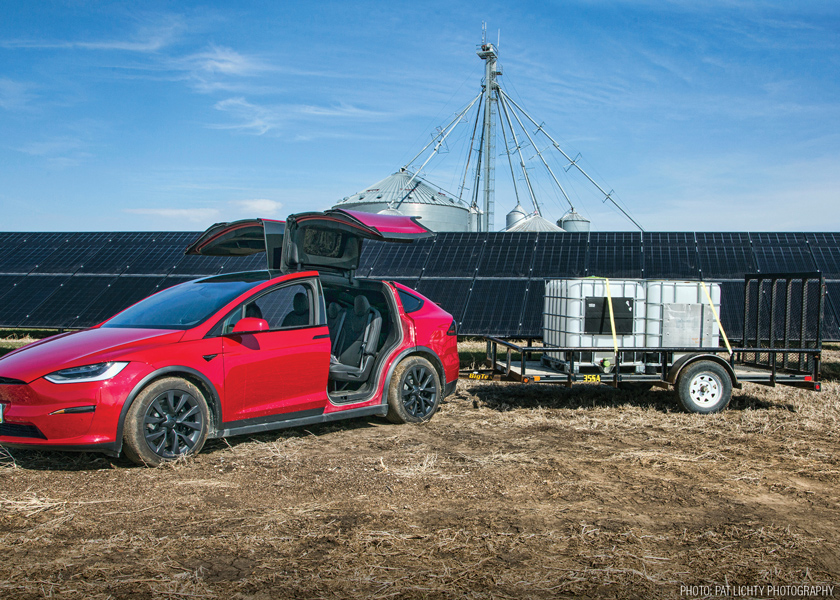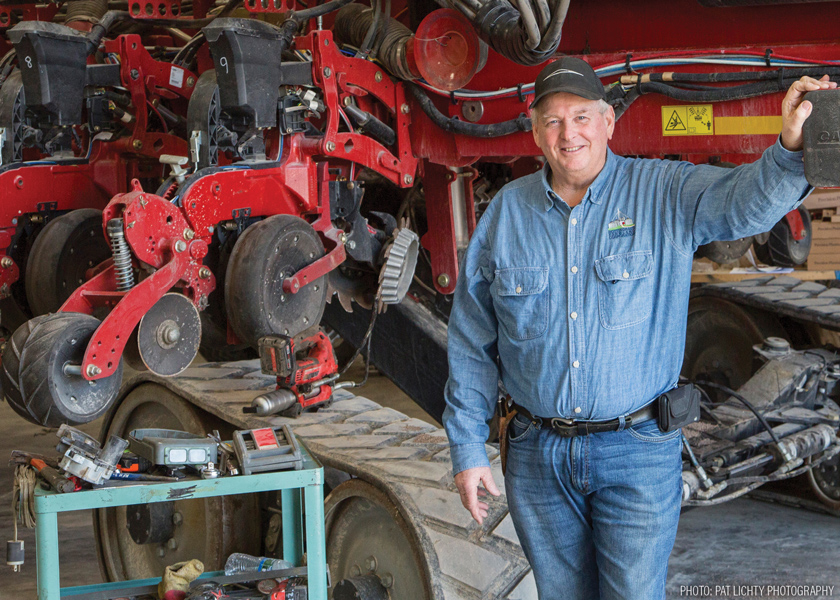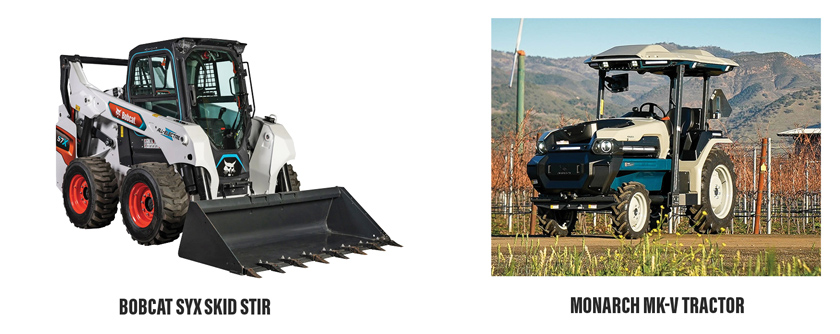The Electric Farm: Rick Rottinghaus Plots A Future Beyond Gasoline And Diesel

An impact wrench rattles another bolt home as Rick Rottinghaus reaches for the next part in this year’s planter upgrades. Time is running out before wheels need to be turning on his family’s Waterloo, Iowa, farm.
“One of my brothers asked the other day, ‘Can’t we get a new piece of equipment without you getting the torch and the welder out?’” he laughs.
The tinkering trait is one Rottinghaus comes by honestly.
“My grandad had the first diesel farm tractor in Black Hawk County and was one of the first to raise soybeans,” Rottinghaus says. “Dad was an inventor, a builder and modified all kinds of things. He ultimately ended up with nine U.S. patents before passing away at age 91.”

This is why folks who know him, aren’t surprised to see Rottinghaus driving an electric car.
“I hook a trailer up to it, and I’ve used it to go get tractor parts in Minnesota; I pulled a tile stringer trailer from Adair, Iowa, to home; I’ve hauled a lawnmower and even picked up lumber,” Rottinghaus says. “Last spring, a raccoon wrecked the fan blade on our sprayer, and I had to drive to Indianapolis to get a new one. I put 900 miles on the car in one day.”
At home, he charges it with the help of a 2-year-old solar array rated at 94 kWh producing 130,000 kWh per year. He feeds power into the grid and in turn the electric company credits that power back.
THE ELECTRIC ECONOMY
Rottinghaus is riding a swelling tide threatening to crash across the globe. The “electric” economy is ready to roll into town this decade as battery technology improves, renewable power generation expands and automakers buy in to a future powered by something other than gasoline and diesel.
“The energy economy is going to transition because the economics of it make it not just reasonable but necessary,” explains former Colorado Governor Bill Ritter.
One of 12 kids, Ritter grew up on wheat farm near Aurora, Colo., and is the founder and director of the Center for the New Energy Economy at Colorado State University. He’s shocked how fast the energy sector is moving from coal toward renewables and natural gas as technology improves.
“It’s coming, [the decarbonized, renewable, electric energy economy],” Ritter says. “There’s a business case, and that’s why farmers should pay attention; Not because a bunch of progressives in San Francisco are telling you it has to come or for the sake of the environment. It’s the business case. Look at what happened to the coal industry. People didn’t pay attention — use that as a cautionary tale.”
For the first time in 2022, electricity generated from renewable sources has surpassed coal. The International Energy Agency reports renewable energy capacity will be able to meet 35% of global power generation by 2025. In the U.S., the Energy Information Administration predicts solar power will make up more than half of the new electricity capacity this year.
“People do view solar as a trade-off because it’s actually taking land out of production, but in Colorado, we’re trying to explore new possibilities around agrivoltaics, or finding ways to utilize solar that’s compatible with agriculture,” Ritter says.

PUT ELECTRIC TO WORK
Rho Motion tracks electric vehicle (EV) sales and says more than 4 million were sold in the first half of 2022, up 60% from a year ago. Congress is investing heavily in infrastructure, with $7.5 billion earmarked to support building more EV charging stations.
Back at the farm, Rottinghaus admits infrastructure is the limiting factor.
“If you hook up a trailer, your range is cut by 25% to 50%,” he says. “A supercharger can give you 70% of your range in 20 minutes, but with the slower chargers, you plug in for an hour and only get 20 extra miles.”
He knows other farmers who tried electric pickups and walked away after becoming frustrated.
“We’re still going to be using gas and diesel engines for years,” Rottinghaus says. “I just think it’s something to add to the toolbox.”
Through the years he’s pulled out other tools, including an on-farm wind turbine. His family had to flee their home when the turbine’s brakes failed during a high-wind event, and it caught fire. That experience taught him technology is always evolving and to look for upgrades and new paths.

BUILDING A BETTER BATTERY
A key area where improvements are needed is battery technology. For now, limitations are holding the ag customer’s foot off the EV accelerator.
For two decades, Larry Curtiss has been studying and working on batteries. He believes his latest research at the Argonne National Laboratory in collaboration with Mohammad Asadi at the Illinois Institute of Technology could hold the key to an electric future by land and by air.
“This type of energy density could be used in planes that fly within the continental United States,” he says.
Essentially, Asadi, Curtiss and their partners have created a solid-state, lithium-based battery capable of pushing EVs from the 250-mile range to 1,000 miles. By eliminating the liquid electrolyte, there’s also no risk of the fires that have been an issue.
“A concern with the current battery technology is it uses some metals that are hard to get, such as cobalt, which is only available in some African countries,” Curtiss says. “Our batteries don’t use cobalt, and the materials are generally easy to find except for lithium.”
That should get easier as new mines come online, such as Thacker Pass currently preparing to open in Nevada (despite legal challenges) and new projects in California’s Imperial Valley, which has some of the largest lithium deposits in the world.
“Once we are able to scale this up to a larger size battery pack, it can change the conversation for electric power, especially for aviation, long-haul trucking or even farm equipment,” Curtiss says.
He expects it will take a few years to engineer and scale the battery up in size but is hopeful it can be ready faster than the previous 15-year timeline current lithium-ion technology required to make its way to automobiles.
UNLIMITED OPTIONS
While Rottinghaus is comfortable plugging in his car, he can picture a similar future for his farm equipment.
“In my mind, instead of pulling a fuel trailer to the field, you’d pull a transformer trailer and plug into the grid,” he says. “Then, you park your combines and tractors there to charge overnight.”
That convenience, combined with so much less maintenance, paints a bright future on the farm, Rottinghaus says.
Ritter says that will impact the economics of EV equipment eventually.
“Thinking about ways to decrease maintenance costs by using electric motors in major farm equipment is going to be part of improving the economic margin for farmers,” he says. “There will be big capital outlays in the beginning, but over time, less maintenance costs will make a big difference.”
As the industry waits for the technology and infrastructure to paint a clearer picture of the future, Rottinghaus is focusing on today and planting his 50th crop this spring.
“I like being on the cutting edge,” Rottinghaus admits. “I just prefer to get there after most of the bloodletting is done.”

Electric Farm Equipment
A flood of new lithium-ion powered equipment is making its way to dealer lots. Just in the past year Case, Caterpillar, Doosan Bobcat, John Deere, Komatsu, Yanmar and Volvo have released prototypes or plans for industrial-sized electric equipment.
Monarch Tractor is already trying to establish a toe hold. Its MK-V tractors have been used in California wineries since 2020. The fully electric, autonomous tractors feature 10 hours of runtime, 70 peak horsepower, 40 hp continuous, and twice the torque of a comparable conventional tractor.
“Electric tractors offer farmers significant reductions in fuel costs over the life of the machine when compared with a diesel-powered tractor of the same capacity,“ says CEO and co-founder Praveen Penmetsa.
Monarch also offers a battery swap cart to keep the tractor running and uses 90% fewer moving parts as a comparable diesel unit.
CNH Industrial has been collaborating with Monarch. In December 2022, it announced an electric tractor prototype, which will ultimately be a Case IH branded model.
”There’s a power density as it relates to technology where it doesn’t work on a 555-hp tractor with today’s technology, but it certainly has a use case with the duty cycle needed up to 50, 70, or 80 hp,” says Kurt Coffey, vice president of Case IH North America.
“I’m not going to say electrification doesn’t have a place in agriculture, but right now, just from a pure physics perspective, not at the high-power levels,“ echoes John Deere’s chief technology officer Jahmy Hindman.
Deere’s findings, he says, also show electrification could be a solution for units of 100 hp and under. “In relatively light duty cycles, lithium-ion chemistry batteries can work,” he says. “As you get into higher power levels? The answer is no.”
Read more about electric farm equipment.








